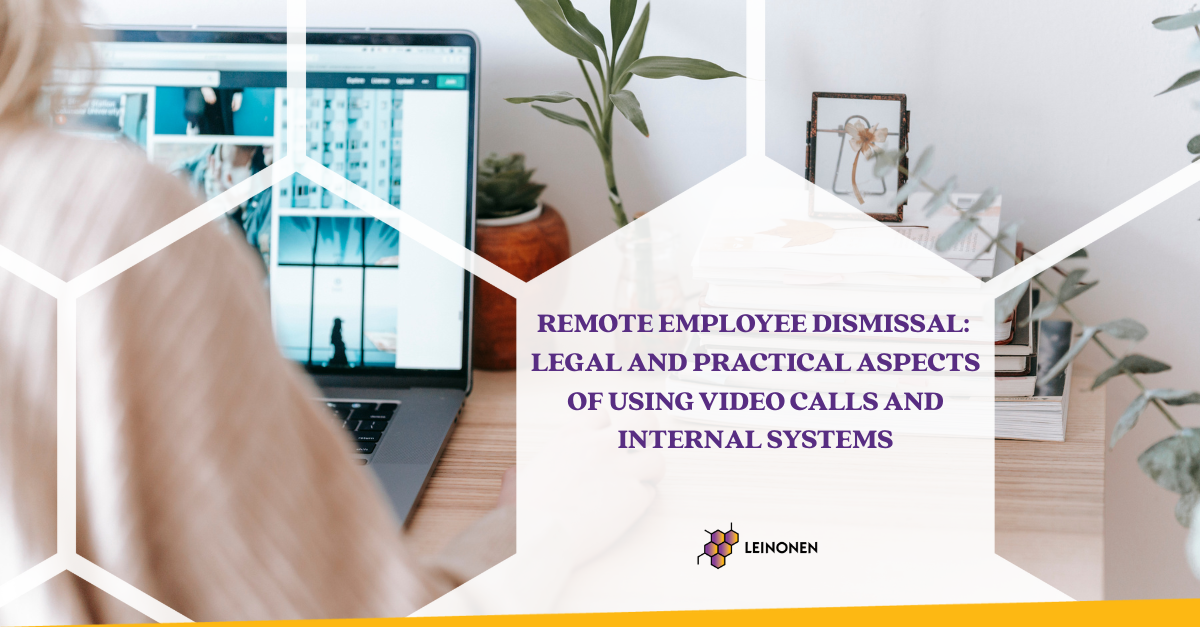Nowadays, technological advancements have significantly transformed internal business processes, including human resource management and employment relationships. Remote work, digitalization, and automated management systems have become commonplace, enabling companies to optimize resources and accelerate decision-making processes. More and more companies are choosing to use digital tools not only for hiring employees but also in the dismissal process.
Traditionally, employee dismissal is a formal and legally regulated process, where written documentation, clear communication, and respect for employee rights play a crucial role. However, the question of whether remote dismissal—such as by video call or through an internal document management system—complies with Latvian Labor Law remains a subject of debate.
This issue is particularly relevant due to three key factors. First, after the COVID-19 pandemic, many companies have retained remote work practices, meaning that employment relationships are increasingly managed remotely. Second, the rapid pace of digitalization has created a need for clear guidelines regarding electronic document flow, communication, and legal evidence in employment termination cases. Third, employees are increasingly working in countries different from where company management is located, introducing cross-border challenges in signing documents and terminating employment relationships.
Although digital tools offer convenience and efficiency, their use in the employee dismissal process raises several questions. Does dismissal via video call comply with the requirements of the Labor Law? How can an employee’s dismissal be legally formalized when using the company’s internal document management system? Does such a process threaten employee rights, and is it sufficiently transparent to avoid disputes and legal risks?
Labor Law Requirements Regarding Employee Dismissal
Employee dismissal is a legally regulated process in which the employer must follow specific conditions to ensure that the termination of the employment relationship is lawful and justified. Section 101 of the Labor Law (“Employer’s Notice”) and Section 112¹ (“Notice Delivery”) set out both the employer’s right to terminate an employment contract and the requirements regarding the method of delivering the notice of dismissal.
The employer has the right to terminate the employment contract in writing only in specific cases clearly defined in Section 101 of the Labor Law. These grounds can be grouped into three main categories:
- Violations of work discipline and ethics,
- Employee’s professional abilities and health condition,
- Organizational and economic reasons.
It is important to note that the employer is obligated to provide a justified reason for termination, and any dismissal must comply with the principles of labor law protection. Unjustified or vague dismissal may be challenged in court.
Section 112¹ of the Labor Law states that the employer’s notice to the employee must be submitted in writing and must be clearly expressed. The law outlines several possible methods of delivering the notice:
- Personal delivery – the employer or an authorized person hands the notice to the employee in person, obtaining their signature as confirmation of receipt;
- Registered mail – sent to the address provided by the employee, considered received on the seventh day after sending;
- Electronic signature – if the employee has previously agreed to receive the employer’s documents in electronic form using a secure electronic signature.
Section 112¹, in conjunction with the reference in Section 101 that employment relationships may only be terminated in writing, is particularly important in the context of remote dismissal. This raises the question: can the use of video calls and internal document management systems be considered a legally valid method of dismissal?
Employee Dismissal Using Video Calls and Internal Document Management Systems
As previously mentioned, Section 112¹ of the Labor Law clearly defines the ways in which an employer is entitled to notify an employee of the termination of their employment contract. The three methods stipulated in the law—personal delivery of the notice, sending it via registered mail, or sending it to the employee’s personal email address specified in the employment contract—are exhaustive and not open to broad interpretation. This has also been confirmed by the case law of the Supreme Court, which has established that this legal norm must not be applied more broadly than explicitly stated.
In this context, it is important to emphasize that an employee’s work email address is not considered an appropriate channel for delivering a termination notice. The reason is simple: the employer has the right to revoke access to the company-provided email system at any time. This could result in a situation where the employee is unable to access the sent document or the termination notice remains in a system they no longer have access to. Such circumstances pose a significant legal risk, potentially leading to disputes over whether the notice was validly delivered in accordance with the law.
Similar considerations apply to internal document management systems. Unless such a system is used merely as a means of forwarding the termination notice to the employee’s personal email address, it is not a suitable method of notification. The rationale is the same as with work email: employer control over system access may prevent the employee from actually receiving and reviewing the notice.
With regard to the use of modern technologies such as video call platforms or other video recording devices, legal doctrine recognizes that these tools can be used to document an employee’s refusal to accept the notice. This is particularly important in situations where the notice is being handed over in person, but the employee refuses to sign for its receipt, and it is not possible to provide witnesses to confirm that the document was read out. In such cases, a video recording may serve as evidence that the termination notice was read to the employee. However, this method does not replace the legally required forms of notice delivery.
A video call can be useful as a communication tool or as a preliminary step, but the termination notice itself must still be delivered using one of the exhaustively listed methods in Section 112¹ of the Labor Law. Otherwise, the employer risks that the notice may be deemed invalid, as it was not communicated in accordance with the legally prescribed procedure.
Conclusion
Remote employee dismissal through video calls and internal company document management systems is a modern approach that can enhance communication efficiency and accelerate the process. However, under Latvian Labor Law, such practices are allowed only as supplementary, not primary, methods. The law clearly defines three permissible ways of delivering a notice of termination: in person, by registered mail, or electronically with a secure e-signature, provided there is an agreement with the employee. Any other method, including internal systems or video calls, is not considered legally sufficient and may pose significant legal risks.
To ensure transparency and legal compliance in the employment termination process, employers must adhere to the statutory requirements and, if necessary, adapt their digital procedures to align with the regulatory framework. Video calls and technological tools may serve as supportive means of communication, but not as legally valid instruments for formalizing the fact of dismissal.





